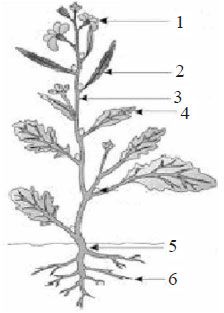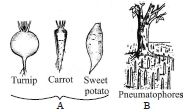Leaves of dicotyledonous plants possess _________ venation, while _________ venation is the characteristic of most monocotyledons.
reticulate and parallel
parallel and reticulate
reticulate and perpendicular
obliquely and parallel
Correct Answer :
A. reticulate and parallel
Leaves of dicotyledonous plants possess reticulate venation while parallel venation is the characteristics of most monocotyledonous. In reticulate venation, the main veins of leaf form numerous irregular branches and as a result a net like arrangements is formed. Reticulated venation is the most common vein formation in leaves. It can be found in the leaves of maple trees, oak trees and rose bushes. In parallel venation veins are arranged parallel to each other.
Related Questions
Which part of plant is generally green when young and later often become woody and dark brown?
stem
seed
leaves
flower
Floral features are chiefly used in angiosperms identification because
flowers are of various colours.
flowers can be safely pressed.
reproductive parts are more stable and conservative than vegetative parts.
flowers are good materials for identification.
The flower is the reproductive unit in the ___________ meant for ___________ reproduction.
angiosperms and sexual
gymnosperms and sexual
algae and asexual
pteridophytes and asexual
Match the column-I containing types of aestivation with their examples given in column-II and choose the correct option.
| Column - I | Column-II |
|---|---|
| (Type of aestivation) | (Examples) |
| A. Valvate | I. Cotton |
| B. Twisted | II. Calotropis |
| C. Imbricate | III. Bean |
| D. Vexillary | IV. Gulmohar |
A I; B II; C IV; D III
A II; B I; C IV; D III
A II; B IV; C I; D III
A II; B I; C III; D IV
The main function(s) of root system is/are
absorption of water and minerals from the soil
storing reserve food material
synthesis of plant growth regulators
All of the above
The part of the root which is most active in water absorption is called
root cap
maturation zone
meristematic zone
zone of elongation
Stilt roots occur in __________ .
groundnut
rice
sugarcane
wheat
The given figure shows the parts of flowering plant. Which parts of the given figure were involved in the following functions:
- Storing reserve food material
- Synthesis of plant growth regulators.
- Absorption of water and minerals from the soil.
- Providing a proper anchorage to the plant parts

5 and 6
1, 2 and 6
1, 2, 3 and 4
2, 4, 5 and 6
Which one of the following characteristics does not belong to parietal placentation?
Ovules are borne on central axis.
Ovary is one-chambered but it becomes two-chambered due to the formation of false septum.
Examples are mustard and Argemone.
Both (b) and (c)
The given figure (A, B, and C) shows different types of roots. Identify the root which is seen in wheat plant and originate from the base of the stem?

A
B
C
Both A and B
A sterile stamen is known as
staminode
anther
pollen grain
filament
Which of the following statements are correct?
- From the region of elongation, some of the epidermal cells form root hairs.
- Pneumatophores are seen in Rhizophora.
- Adventitious roots are seen in the banyan tree.
- Maize and sugarcane have prop roots.
(i) and (iv)
(i), (iii) and (iv)
(iii) and (iv)
(ii) and (iii)
The mature seeds of plants such as gram and peas, possess no endosperm, because
these plants are not angiosperms.
there is no double fertilization in them.
endosperm is not formed in them.
endosperm gets used up by the developing embryo during seed development.
Which of the following option shows the correct labelling of the parts of leaf marked as A, B, C and D.

A - Lamina, B - Axillary bud, C - Stipule, D - Leaf base
A - Lamina, B - Stipule, C - Axillary bud, D - Leaf base
A - Lamina, B - Axillary bud, C - Stipule, D - Pedicel
A - Leaflet, B - Axillary bud, C - Stipule, D - Leaf base
Which is not a stem modification ?
Rhizome of ginger
Corm of Colocasia
Pitcher of Nepenthes
Tuber of potato
How many plants in the list given below have marginal placentation?
- Mustard
- Gram
- Tulip
- Asparagus
- Arhar
- Sunhemp
- Chilli
- Colchicine
- Onion
- Moong
- Pea
- Tobacco
- Lupin
Four
Five
Six
Three
During the post-fertilization period, the ovules develops into ___A____ and the ovary matures into a ___B ____.
A - seeds; B - fruit
A - fruit; B - seeds
A - flower; B - seed
A - seeds; B - flower
The root differs from stem in having
nodes and internodes
axillary buds
multicellular hairs
unicellular hairs
Leaves of dicotyledonous plants possess _________ venation, while _________ venation is the characteristic of most monocotyledons.
reticulate and parallel
parallel and reticulate
reticulate and perpendicular
obliquely and parallel
Which type of function is performed by the fleshy leaves of onion and garlic?
Storage
Reproduction
Photosynthesis
Protection
Root hairs develop from
region of maturation
region of elongation
region of meristematic activity
root cap
Which of the following statements is correct?
Imbricate aestivation is found in papilionaceous family.
Generally sepals are green, leaf like and protect the flowers in the bud stage.
In cymose type of inflorescence, the main axis terminates in a flower, hence is limitless in growth.
In axile placentation ovary is one chambered but it becomes two cambered due to formation of the false septum.
The region of the stem where leaves are born are called ____________ while ____________ are the portions between two ____________.
nodes, nodes and internodes
nodes, internodes and nodes
internodes, nodes and nodes
internodes, internodes and nodes
The given figures (A and B) shows the modificaiton of roots.Which of the following statements regarding the figures is correct ?

Tap roots of carrot, turnip and adventitious root of sweet potato, get swollen and store food.
Pneumatophores conducts water, minerals & photosynthesis
Pneumatophore is found in the plants that grow in sandy soil.
Turnip & carrot shows adventitious roots and sweet potato shows tap root.
A scar on the seed coat through which the developing seeds attached to the fruit is called as ________.
testa
tegmen
hilum
micropyle
Which of the following is a modified stem for the protection of plants from browsing animals?
Tendrils
Thorns
Rhizome
Tuber
Prop roots of banyan tree are meant for
respiration.
absorption of water from soil.
providing support to big tree.
all of the above.
Which of the following is not the characteristic features of fabaceae?
Tap root system, compound leaves and raceme inflorescence.
Flowers actinomorphic, twisted aestivation and gamopetalous.
Stamens 10, introrse, basifixed, dithecous.
Monocarpellary, ovary superior and bent stigma.
Alternate type of phyllotaxy is found in
china rose
mustard
sunflower
all of these
Which of the following groups of plants have underground stems?
Potato, ginger, turmeric, Euphorbia, zaminkand
Potato, ginger, turmeric, zaminkand, Colocasia
Potato, Citrus, Opuntia, zaminkand, Colocasia
Potato, cucumber, watermelon, zaminkand, Colocasia
